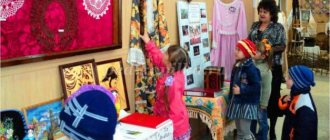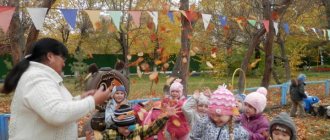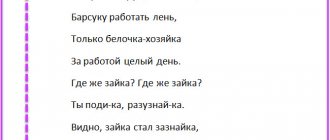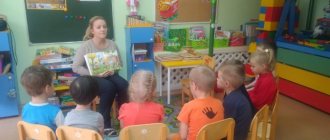Organization of project activities of a teacher in a preschool educational institution.
During the introduction of the Federal State Educational Standard for Preschool Education, kindergarten teachers often began to use the design method in their work. This allows you to successfully plan both the educational process and its results.
Project activities have become a bright, developing, interesting method in the work of teachers. If you apply this method systematically, you can track the effectiveness.
The ability of a teacher to analyze the result of his work, the development of a child as an individual who knows how to think, plan, implement, and be able to apply the resulting product of his work in life, in practice, are important qualities of modern education.
Implementing various projects together with children in kindergarten, involving the parent community in joint activities allows us to raise a child as a creative, independent person who can achieve his goals and objectives. This method, like no other, involves the cooperation of children and adults, which has a positive effect on the child’s psyche and allows him to feel more confident and harmonious in society. Such children graduate from kindergarten and move on to a new level of education at school. More confident, successful, it is easier for them to make contact with adults and peers.
There are many projects that can be applied and used in kindergarten: these are thematic projects (informational, creative, gaming, research). The following projects have been implemented in our kindergarten: “Fantasies with Legos” (game), “Properties and Possibilities of Water” (research), “The Art of Origami” (creative), “Trees and Shrubs of Our Site” (informational). A different number of students took part in the implementation of all these projects. Some projects were prepared by several children, while others required the participation of the entire group of children, and there were also individual ones.
All projects are different in volume and capacity and require different time frames for implementation. For example, a project on the work of the Ural children's writer Pavel Petrovich Bazhov was long-term, lasting the entire academic year. Familiarization with the work of this writer is a very difficult process for preschoolers; the material is very voluminous and requires detailed examination (for example, many words in fairy tales are difficult for a child to understand).
The “Dinosaurs” project was of average duration, the children easily posed and solved the assigned problems, the search for material and its perception was easy. This suggests that this topic is closer and more interesting to the modern child.
When decorating corners in a group, preparing a group for the holidays, children collect information and put it into practice, together with the teacher they come up with how best to decorate the group, for example, for the New Year, in order to take a prize. First, they collect information together with the teacher and parents, then discuss what suits them, what they can handle on their own, and where adult help is needed. To involve me in making attributes, I spent leisure evenings with my parents, where we worked together on preparation. This form of cooperation brings children, parents and kindergarten staff closer together.
The main thing when using project activities is the result. It can be designed and presented in different ways: this is a holiday, and the design of newspapers, albums, exhibitions, as well as playing a game, for example, playing out the characters of a fairy tale, getting into character. Such final events allow children to look for ways to solve problems, solve them in their own way, in an accessible form.
Project activities must be carried out sequentially:
preparatory activity: The teacher, together with the children, formulates the problem, looks for solutions, collects information together with the children, and involves the parent community. Schemes are created, templates, card files, attributes and other necessary material are prepared.
It is decided where, in what place, the selected project will be implemented, and the time frame that will be spent on its implementation is specified.
the project itself, its development: The work plan is determined. System-forming factors are selected. Deadlines are set. The teacher takes an active part in the development of the project, provides assistance if necessary, guides the children, but in no case does the work that the children themselves can do. In the process, children must develop and develop certain skills and acquire new useful knowledge and skills.
checking the quality of the project: There is a self-test, a mental assessment of one’s activities, one’s work. Experts can be selected who will also evaluate the children’s work (kindergarten specialists are selected as experts: speech therapists, physical education instructor, music director, senior teacher, parents). But in no case can an expert be the specialist who helped implement a certain project; he will not have an objective assessment. For example, during the implementation of the project “I love the Urals - my native land!”, the music director was directly involved, she helped in staging the play, and learned songs about the Urals. She is a participant and cannot be an expert.
When checking a project, they assume how it can be used in practice, how work on the project influenced the participants in this project.
If the experts made comments, then the participants (children, teachers, parents) must rethink it, edit it, and improve it.
At this stage, children learn to evaluate their work, accept criticism, correct comments, and improve their work. A sense of responsibility for the quality of your project develops.
After this action, the implementation of the project in practice begins. Some projects do not require going through all of these stages to develop.
A full cycle of all actions is typical for large-scale ideas. Projects that are lighter, smaller in scale, are created in a short time and do not require going through all the stages. They seem to be compressed, rolled up.
Together with the children, we were so carried away by the project activity that we wrote a small quatrain: It is not difficult for us to engage in a project, It carries us away and promises to move forward! It helps us make friends and unite, and gives us new ideas!
Project “Dinosaurs” in the preparatory group in Yekaterinburg.
A project to prepare a group for the New Year together with parents.
Author: Churkina Tatyana Gennadievna, teacher, MBDOU kindergarten No. 463, Ekaterinburg, Sverdlovsk region, Russia
The article is published in the author's edition
Report on the topic: “The relevance of the project method. Features of its use in elementary school"
Municipal state educational institution
“Vinogradnenskaya secondary school named after. Dedova F.I.”
Report on the topic:
“The relevance of the project method, features of its application in elementary school”
Performed:
Pogorelova Irina Viktorovna,
primary school teacher
MCOU "Vinogradnenskaya Secondary School named after. Dedova F.I.”
first qualification category
Vinogradnoye village, 2016
An educated person in modern society is a person who is not so much armed with knowledge as he is able to obtain knowledge, apply it in practice and do it purposefully. There is a need to go beyond the existing traditional approaches, to work in a mode that encourages the search for new information, independent productive activities aimed at developing the student’s creative thinking.
Currently, global changes have occurred in the education system: previous values, priorities, targets and pedagogical means have been revised.
The modern school is focused on developing in students a broad scientific outlook, general cultural interests, and establishing in the minds of the priorities of universal human values. Therefore, one of the main tasks of a modern primary school is to create the necessary conditions for the personal development of each child and the formation of his active position. In this regard, there is a need to prepare elementary school students for activities that teach them to think, predict and plan their actions, develop the cognitive and emotional-volitional sphere, create conditions for independent activity and cooperation, and allow them to adequately evaluate their work.
The need to solve this problem in my teaching activities prompted me to use the project-based teaching method as a new modern pedagogical technology. The first place comes to forms of independent work of students, based not only on the application of acquired knowledge and skills, but also on obtaining new ones based on them.
The main goal of my teaching activity is to demonstrate and develop
children’s personal interest in acquiring knowledge .
In this regard, I devote a significant role in my work
to project activities
, which allow:
- identify the child’s creative abilities;
- improve contact with students and parents;
- develop research, communication and collaboration skills;
- provide children with emotional and meaningful support for their self-affirmation.
There are many ways to develop the intellectual and creative potential of a child’s personality, but one’s own design and research practice is undoubtedly one of the most effective.
Primary school age is the initial stage of entry into project activities, laying the foundation for further mastery of it. The inclusion of younger schoolchildren in project activities teaches them to think, predict, anticipate, and forms adequate self-esteem.
Of course, primary school age imposes natural restrictions on the organization of project activities, but it is imperative to involve primary school students in project activities. The fact is that it is at primary school age that a number of value systems, personal qualities and relationships are laid down. If this circumstance is not taken into account, if this age is considered as insignificant, a “passing age” for project methods, then the continuity between the stages of development of educational and cognitive activity of students and a significant part of schoolchildren is disrupted and it is not possible to subsequently achieve the desired results in project activities. When organizing project activities in elementary schools, it is necessary to take into account the age and psychological and physiological characteristics of younger schoolchildren.
The Vinogradnenskaya Secondary School, where I teach, has been working on the Planet of Knowledge teaching programs for eight years. A characteristic feature of textbooks is their focus on organizing project activities. Any student has the opportunity to choose a project topic in accordance with their interests and capabilities.
In the set of textbooks, project activities act as the main form of organizing extracurricular activities for schoolchildren. Special spreads in the textbooks present possible options for creative, informational and practice-oriented projects. Moreover, on each of these spreads there is always a proposal to create the student’s own project.
I am convinced that it is necessary to include schoolchildren in project activities from the 1st grade, gradually. For each class, its own specifics of working on the project are determined, taking into account the age and psychological characteristics of the development of younger schoolchildren.
In the first grade, working on a project with a complete structure is impossible, since children do not know how to read, write, or analyze. Therefore, in the first half of the year, I conduct a preparatory stage, which includes: students’ creative work (drawings, crafts, applications), oral stories, in which children, with the help of the teacher, gradually learn to analyze, reason, and highlight the main thing.
In the second half of the year, children can already read, have basic writing skills, and can ask and answer questions. Consequently, it is possible to expand the scope of work on the project and include not only drawings, but also the collection of information according to a plan drawn up together with the teacher. Taking into account the developmental characteristics of younger schoolchildren, a first-grader needs to be offered topics that are closest and most significant to him, for his “small world” (“City of Letters”, “Living ABC”, “Book of Riddles”).
In the first and second grades I teach how to work in a group, since it is very difficult for children to agree among themselves and come to a common opinion. My task is to teach children the art of communication, understanding, interaction. During this period, children learn to work with a book in the library, find the necessary information in various sources on a given topic, draw up projects and defend them. (“Cities of Russia”, “Russian folk proverbs”, “My genealogy”, photo report “My small homeland”, wall newspaper “This Victory Day”, etc.)
The full application of the project method begins in grades 3-4. The topic of the project should be interesting to the student and should captivate him. Schoolchildren - the authors of projects - show special activity and personal interest in obtaining results if projects are created on problems that concern them and were proposed by them independently.
Work on project activities has become firmly established in the life of primary school and has become a significant contribution for it in solving problems posed both during and after school hours.
Project activities allow students to go beyond the scope of school subjects, make interdisciplinary connections, combine existing life experience with new knowledge, develop an active life position, and make the most of existing creative opportunities.
For many years, we, teachers of the MCOU "Vinogradnenskaya Secondary School named after F.I. Dedov" We successfully apply project activities in our practice, obtaining good results. Presentations of project activities occur at different levels:
— School project week and Project Festival.
— Regional scientific and practical conference “Iuventa”:
2010
— “A proverb is folk wisdom” — 1st place — Pogorelova I.V.
2011
— “Kalmyk kibitka” — 1st place — Pogorelova I.V.
2012
. — “Our names, what they mean” — 2nd place — Pogorelova I.V.
“Lullabies” - 2nd place - Ponomareva T.R.
“Finger Puppet Theater” - 2nd place - Geyser M.A.
“Indoor plants are our friends” - 2nd place - Churbanova T.A.
2013
- "Computer games. Harm or benefit” - 1st place - Ponomareva T.R.
“Kalmyk tea is not easy tea” - 2nd place - Dikushina T.I.
2014
– “Streets of our village” – 1st place – Ponomareva T.R.
“Our cool newspaper “Country of Friendship” - 3rd place - Dikushina T.I.
2016
— “90 years is not an age. Long-Livers of the Village of Vinogradnoye" - 1st place -
Pogorelova I.V.
In the period from 2010 to 2016 -
I places - 5, II places - 5, III places - 1 = 11 places.
— Republican scientific and practical conference “Iuventa”:
2010
— “A proverb is folk wisdom” — 1st place — Pogorelova I.V.
2014
– “Streets of our village” – 1st place – Ponomareva T.R.
2016
— “90 years is not an age. Long-Livers of the Village of Vinogradnoye" - 1st place -
Pogorelova I.V. In the period from 2010 to 2016 -
1st place - 3 first places.
Thus, the use of the project method by the teacher makes it possible to intensify the cognitive activity of students, makes the educational process non-traditional, and contributes to the manifestation of the individual qualities of each student.
It is very important that students receive satisfaction from the results of their work and feel a festive atmosphere because they brought joy to their classmates and teacher. The guys understand how much they still don’t know and how much they have to learn. They develop a sense of responsibility towards their classmates, as they realize that if someone does not complete part of their work, then everyone will suffer and the desired result will not be achieved. Children see that there are many solutions to the same problem, and this is where their creativity comes into play. If a student is able to cope with work on an educational project, one can hope that in adult life he will be more adaptable: he will be able to plan his own activities, navigate in a variety of situations, work together with different people, i.e. adapt to changing living conditions.
All this allows us to consider project activity one of the most effective teaching methods at the present stage of educational development.
5
The developing pedagogy of nonviolence has significantly changed the attitude of adults towards children. The level of development of the child becomes a measure of the quality of the work of the teacher and the entire educational system as a whole. Preschool teachers focus not only on preparing for school, but also on preserving a full-fledged childhood in accordance with the psychophysical characteristics of the developing personality. Respect for the child, acceptance of his goals, interests, creation of conditions for development are essential conditions for a humanistic approach.
Adults should not only pay attention to the formation of knowledge, skills and abilities of a preschooler and his adaptation to social life, but also teach through a joint search for solutions, provide the child with the opportunity to independently master the norms of culture.
A unique means of ensuring cooperation, co-creation between children and adults, and a way to implement a person-centered approach to education is design technology.
Design is a complex activity, the participants of which automatically, without a specially proclaimed didactic task on the part of the organizers, master new concepts and ideas about various spheres of life.
The project method arose in the 1920s in the USA and is associated with the development of the humanistic trend in philosophy and education, which was started by the American philosopher, psychologist and teacher J. Dewey. The method was developed in the works of V. Kilpatrick and E. Collings. The broadest definition of this concept is as follows: “A project is any action performed with all the heart and with a specific purpose” (according to Kilpatrick’s definition).
The ideas of the project method in Russia appeared simultaneously with the development of American teachers. Under the leadership of Shatsky, a group of teachers united, using the project method in practice.
Types of projects.
E.S. Evdokimova offers the following classification of types of projects relevant for preschool education:
- According to the dominant method: research, informational, creative, gaming, adventure, practice-oriented.
- By the nature of the content: include the child and his family, the child and nature, the child and the man-made world, the child, society and culture.
- According to the nature of the child’s participation in the project: customer, expert, performer, participant from the inception of the idea to the receipt of the result.
- By the nature of contacts: carried out within one age group, in contact with another age group, within a preschool educational institution, in contact with family, cultural institutions, public organizations (open project).
- By number of participants: individual, pair, group and frontal.
- By duration: short-term, medium-term and long-term.
Research projects.
According to E. Polat, projects require a clear structure, defined goals, relevance of the subject of research for all participants, social significance, and thoughtful methods for processing the result. In recent years, research projects have been actively conquering the space of schools and kindergartens. For example, a trip along the Volga. For 3 days there is a conversation about travelers: who traveled on what, determining the route, the journey itself, rest on the shore, return. Exchange of impressions, presentation of results, presentation.
Design technology in preschool educational institutions.
Thematic project plan.
- Theme and its origin.
- Related activities and concepts that can be learned during the project.
- Necessary materials.
- Questions for children about the proposed project:
- What do we know?
- What do we want to know?
- How can we find answers to our questions?
5. Evaluation. What new did you learn? (From the point of view of the children and the teacher)
6. Proposals for expanding and improving the project.
Design mechanism.
A teacher is an organizer of children's productive activities, a source of information, a consultant, an expert. He is the main leader of the project, and at the same time he is the child’s partner and assistant in his self-development.
Motivation is enhanced due to the creative nature of children's activities; the child gets acquainted with different points of view, has the opportunity to express and justify his opinion.
Design technology requires an appropriate organization of the subject-development space of the group. The group contains documents, books, various objects, encyclopedias that are accessible to their understanding. It is possible for children to go to libraries, museums or other institutions if necessary for the implementation of the project.
Design technology is focused on the joint activities of participants in the educational process in various combinations: teacher - child, child - child, children - parents. Joint-individual, joint-interacting, joint-research forms of activity are possible.
One of the advantages of design technology is that each child is recognized as important and necessary in the team. He sees the results of the group's collective efforts. A private, specific result of work for children can be a drawing, an appliqué, an album, a written fairy tale, a prepared concert, a performance, a book, a harvest, etc. During the implementation of the project, children develop independence, activity, responsibility, a sense of trust in each other, and interest in cognition.
Development of children's design skills.
Design abilities are manifested in the interaction of the main management systems of any social organization (person, team, activity).
The main function of design is to outline a program and select means for further targeted actions.
The implementation of design technology in the practice of preschool educational institutions begins with an orientation towards the current problem of cultural self-development of a preschooler and familiarity with design cycles. The design process consists of three stages: project development, implementation, and analysis of results.
A teacher who knows the project method as a technology and as an activity for self-organization of a professional space can teach a child to design.
Design abilities are manifested in the interaction of the main management systems of any social organization.
The design process consists of three stages: development of projects, their implementation, analysis of results.
The condition for mastering each stage is the collective mental activity of educators, which allows:
- focus on the creative development of the child in the educational space of the preschool educational institution;
- learn the algorithm for creating a project based on children’s requests;
- be able to connect to the goals and objectives of children without ambition;
- unite the efforts of all subjects of the educational process, including parents.
You can design collectively: matinees, evenings of entertainment, days of creativity, vacations.
Creative teams of specialists are capable of developing system and system-translated projects.
Project criteria.
- The relevance of the project, the reality of the proposed solutions, the practical focus on the development of the child.
- Volume and completeness of development, independence, completeness.
- The level of creativity, originality in the disclosure of the topic, approaches, solutions proposed by the teacher.
- Reasoning behind the proposed solutions and approaches.
- Proper design: compliance with standard requirements, quality of sketches, diagrams, drawings.
After protecting the project, they move on to its implementation, i.e. to the second stage of work. The third, final, is held in the form of a seminar.







